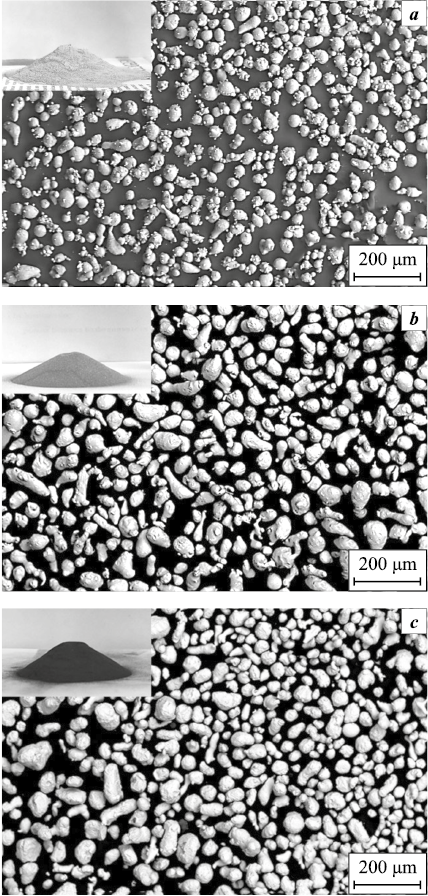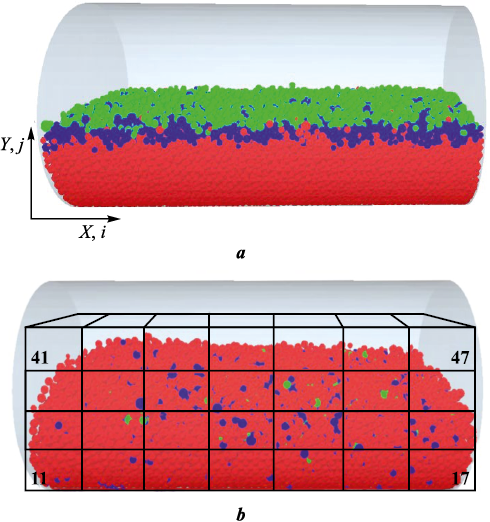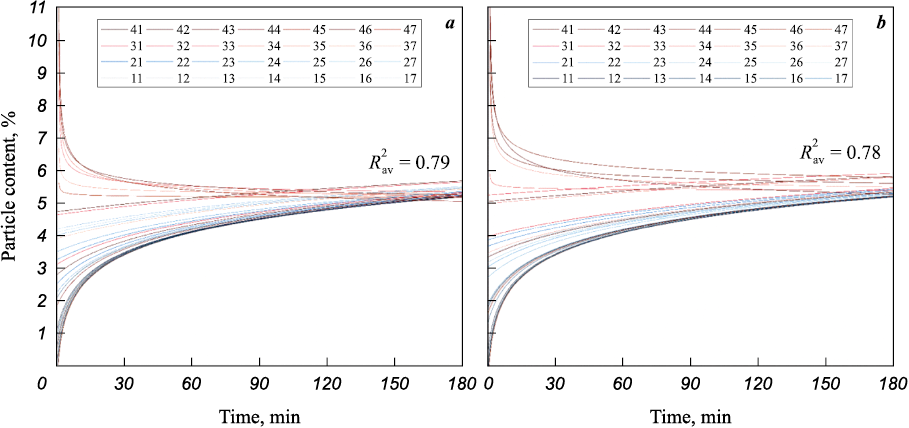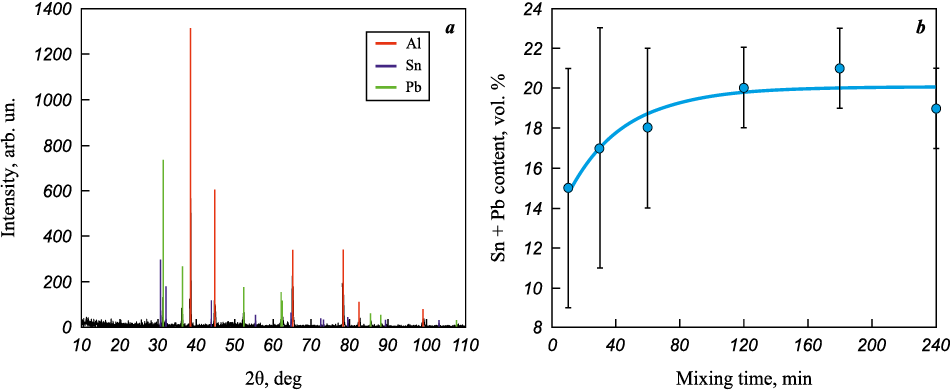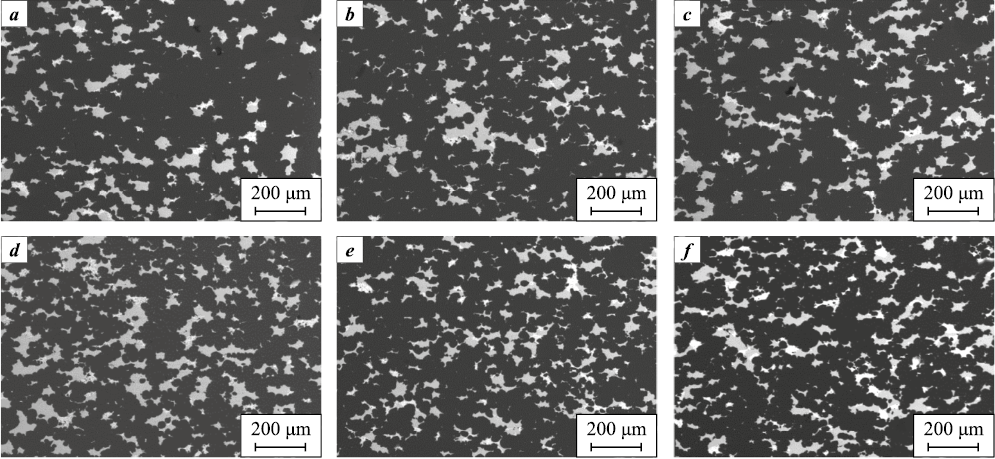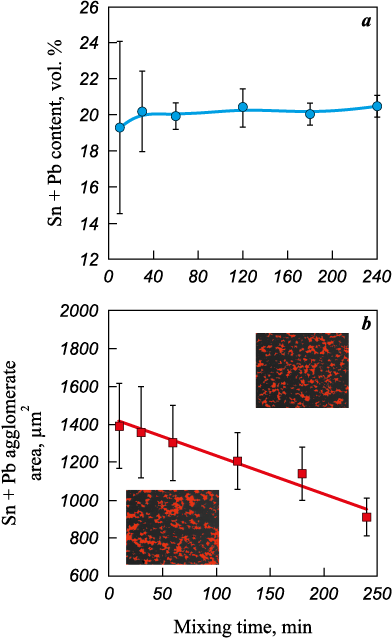Scroll to:
Optimization of powder mixing parameters for the Al–Sn–Pb system for use in selective laser melting
https://doi.org/10.17073/1997-308X-2025-2-15-23
Abstract
This study presents the results of research on optimizing powder mixing parameters for the Al–15Sn–5Pb (vol. %) system for application in selective laser melting technology. The primary focus is on ensuring the uniform distribution of soft-phase particles (Sn and Pb), which is essential for obtaining products with a homogeneous structure and improved tribological properties. The initial materials used in the study were aluminum (ASD-1), tin (PO-1), and lead (PS-1) powders. Before mixing, the powders were sieved using mesh sizes ranging from 50 to 25 µm. The sieved powders had a nearly spherical shape and good flowability characteristics (less than 25 s / 50 g). The effect of mixing time on the homogeneity of the powder mixture was studied using the discrete element method and a modified Hertz–Mindlin model. The obtained mixtures were analyzed using X-ray phase analysis, micro-X-ray spectral analysis, and graphical analysis methods. Subsequent experimental validation confirmed the reliability of numerical calculations and enabled the assessment of optimal mixing parameters. It was established that the optimal mixing time for achieving a uniform distribution of the initial powder particles falls within the range of 60 to 120 min. It was also found that the complex motion pattern of a Turbula-type mixer reduces the impact of gravitational segregation, thereby improving the uniform distribution of soft-phase particles (Sn + Pb). The proposed approach can be used for developing new powder preparation methods for additive manufacturing technologies and for creating composite materials with enhanced performance characteristics.
Keywords
For citations:
Akimov K.O., Skorentsev A.L., Rusin N.M., Likharev V.E., Nikonov A.Yu., Dmitriev A.I. Optimization of powder mixing parameters for the Al–Sn–Pb system for use in selective laser melting. Powder Metallurgy аnd Functional Coatings (Izvestiya Vuzov. Poroshkovaya Metallurgiya i Funktsional'nye Pokrytiya). 2025;19(2):15-23. https://doi.org/10.17073/1997-308X-2025-2-15-23
Introduction
The growing demand for high-performance antifriction materials in advanced engineering applications is driving the development of new metallic powder compositions designed to produce components with enhanced tribological properties [1–3]. This trend, combined with the rapid adoption of additive manufacturing technologies, imposes stricter requirements on the preparation of multicomponent powder mixtures. The extreme nonequilibrium conditions of the selective laser melting (SLM) process, characterized by intense heating (>106 K/s) and cooling rates (103–108 K/s), necessitate a high degree of homogeneity in the initial powder mixture, as any inhomogeneities can lead to structural defects and anisotropy, ultimately degrading the properties of the final components [4; 5].
Aluminum alloys are among the most widely used materials across various industries due to their unique combination of strength and low density, enabling the production of lightweight yet durable machine components. The integration of aluminum alloys into 3D printing technologies further enhances their appeal by providing additional design flexibility in terms of shape and structure [6]. The Al–15Sn–5Pb (vol. %) system is a specialized alloy intended for antifriction applications, such as sliding bearings, where tin and lead act as solid lubricants, reducing wear during frictional contact [7–9]. However, the tendency of these inclusions to segregate during both powder mixing and solidification in the 3D printing process necessitates stringent control over the composition of the powder mixture to ensure their uniform distribution in the final product [10]. Additionally, the relatively low evaporation temperature of lead (1749 °C) compared to the typical process temperatures of aluminum alloy SLM (>2000 °C) requires precise energy input control to prevent selective evaporation [11].
Mixing powders with significant density differences poses a fundamental challenge [12]. In the Al–15Sn–5Pb system, where the density ratio of lead to aluminum is approximately 4.2:1.0, this issue becomes particularly pronounced. Traditional drum mixers, which operate mainly by gravitational forces, tend to promote segregation rather than effective mixing in such systems, as denser lead and tin particles naturally migrate downward. This results in localized inhomogeneities in the powder mixture, which is critical for its subsequent use in SLM [13]. One potential solution to this problem is the use of a Turbula-type mixer manufactured by Vibrotechnik (Russia), which combines rotational and translational motion in a rhythmic three-dimensional pattern. This complex motion induces intense mixing conditions that counteract gravitational effects, thereby reducing segregation driven by density differences. The powder layer periodically experiences near-weightlessness, followed by abrupt directional changes, which help prevent agglomeration.
The objective of this study was to evaluate the effectiveness of the modified Hertz–Mindlin model in predicting the quality of the resulting powder mixture composed of components with significant density variations, as well as to determine the optimal mixing parameters for the Al–15Sn–5Pb system using a Turbula-type mixer. The research focused on identifying the minimum mixing time required to achieve compositional homogeneity sufficient for the successful application of powder mixtures with large density differences in the SLM process.
Materials and methods
The experiments were conducted using aluminum (ASD-1), tin (PO-1), and lead (PS-1) powders. The powders were sieved through meshes with an upper cell size limit of 50 µm and a lower limit of 25 µm.
Analysis of several scanning electron microscopy (SEM) images revealed that the average particle size of all studied powders was 30 µm (Fig. 1), with a size distribution approximating a normal distribution. The aluminum powder particles had a spherical shape, whereas the tin and lead powders exhibited both spherical and dumbbell-like morphologies.
Fig. 1. SEM images of Al (a), Sn (b), and Pb (c) powders |
Additionally, powder flowability was analyzed using funnels with outlet diameters of 2.5 mm (tin, lead) and 5 mm (aluminum) according to GOST 20899–98 (ISO 4490–78). Measurements of the natural repose angle showed that its value for all three powders was approximately 30°. The flowability of the tin and lead powders did not exceed 20 s/50 g, while that of aluminum was 26 s/50 g, indicating their suitability for SLM technology.
Mixing simulations were performed using the discrete element method (DEM) with the Altair EDEM software package (Altair Engineering, USA). The particle-to-particle and particle-to-wall interactions were described by the Hertz–Mindlin model, modified according to the Johnson–Kendall–Roberts (JKR) theory [14; 15]. This contact interaction model is widely used in powder mixing simulations to account for adhesion forces [16–21]. To accelerate computational time, model scaling was applied, reducing the container size and powder mass by a factor of three.
The physical parameters of the powders used in the model are presented in Tables 1 and 2. The friction and restitution coefficients were averaged based on data from various sources [22–26]. For Sn and Pb friction pairs, the friction coefficients were taken from similar bearing steels with comparable properties.
Table 1. Physical parameters of powders used in the simulation
Table 2. Friction and restitution coefficients of the simulated powders
| |||||||||||||||||||||||||||||||||||||||||||||||||||||||||||||||||||||||||||||
To analyze the variation in the tin and lead powder content during mixing, the container volume was conditionally divided into 28 cells, where the fraction of each metal’s particles was assessed using the formula Nij /Vij , where Nij is the number of Sn and Pb particles, Vij is the cell volume, and i and j are the cell indices along the X and Y axes, respectively (Fig. 2).
Fig. 2. Container model with powders at the beginning (a) and after 3 h of mixing (b) |
In a Turbula-type mixer, the powder mixture was blended at a container rotation speed of 30 rpm. The mixing duration varied within the range of τ = 10÷240 min. From the obtained mixtures, 10 compacts were produced by pressing, with the powder for each compact being taken from different parts of the container.
An initial analysis of the composition of the initial components in the powder mixture was performed using X-ray phase analysis with a DRON-8 diffractometer (NPP Burevestnik, Russia) in CuKα radiation (λ = 1.5406 Å) over a 2θ range of 10–110°.
For metallographic studies, cross-sections of the compacts along their diameters were examined. The microstructural analysis of the obtained compacts, as well as the elemental composition assessment, was conducted using a LEO EVO 50 scanning electron microscope (Carl Zeiss, Germany) equipped with an energy-dispersive X-ray spectroscopy (EDS) module. The graphical analysis of SEM images of the compact cross-sections was performed using ImageJ software (National Institutes of Health, USA).
Results and discussion
Simulation
The simulation results for the number of tin and lead particles in different areas of the container over 3 h of mixing, approximated by logarithmic dependencies, are presented in Fig. 3. It was found that at a mixing duration (τ) of up to 30 min, the majority of both lead and tin particles remain predominantly in the upper layers of the powder mixture, despite the complex motion pattern of the container during the process. This may be attributed to the formation of temporary agglomerates of Sn and Pb particles, as these powders exhibit a high tendency toward adhesion due to their lower hardness and high plasticity compared to aluminum, leading to the formation of more stable contacts. As τ increases to 60 min, the dependencies of Sn and Pb particle content in different cells converge within the 4–6 % range and nearly equalize at 180 min.
Fig. 3. Dependences of the content of Sn (a) and Pb (b) particles in the cells (11÷47) |
Based on these results, it can be assumed that to obtain a near-homogeneous Al–15Sn–5Pb mixture, the minimum mixing time in the Turbula mixer should be 60 min at a container rotation speed of 30 rpm.
Experiment
A typical diffractogram of a compact made from the Al–15Sn–5Pb mixture and the dependence of the soft-phase (Sn + Pb) content on the mixing time, calculated using the corundum number method, are presented in Fig. 4. It can be observed that at short mixing times, the soft-phase content is lower (15 vol. %), with significant variations (6 %) in its values (Fig. 4, b). These data partially confirm the simulation results, indicating the presence of soft-phase particle agglomerates. The expected tin and lead content levels in the mixture are reached after 60 min of mixing, confirming the reliability of the applied numerical model. In the 120–180 min time range, the dependence acquires a linear character, and the variation in soft-phase element content does not exceed 2 %.
Fig. 4. Typical diffractogram of the Al–15Sn–5Pb mixture (a) |
The results of SEM studies, presented in Fig. 5, indicate that at short mixing times (τ = 10–60 min), an uneven distribution of soft-phase particles is observed, with large agglomerates of various shapes reaching 300 µm in size. The use of such powder mixtures in SLM would likely result in large defects due to local inhomogeneities in the initial powder distribution. At τ = 120–240 min, tin and lead become more evenly distributed across the polished section surface, and the size of soft-phase agglomerates decreases. Completely eliminating these agglomerates is not feasible due to the inherent tendency of these powders to adhere. However, at this stage, the powder mixtures can be considered suitable for SLM technology.
Fig. 5. Typical SEM images of cross-sections of powder compacts obtained from mixtures |
The EDS analysis results of the compact element composition are presented in Table 3. According to the data, even at short mixing times, the mixture contains Sn and Pb levels close to the target composition. However, due to inhomogeneous distribution within the powder volume, a significant deviation from the mean is observed in different sections of the compacts. After 60 min of mixing, these deviations are reduced by approximately a factor of two, indicating the breakdown of large agglomerates. Mixing for 120 min or longer further decreases the deviation from the average element content within different compact sections to ≈2 %, suggesting that the elements have reached a sufficiently homogeneous distribution throughout the volume.
Table 3. Elemental content in powder compacts depending on mixing time
| ||||||||||||||||||||||||||||||||||
In addition to EDS analysis, graphical analysis of SEM images was conducted using ImageJ software to assess the quantity and size of soft-phase (Sn + Pb) agglomerates (Fig. 6). The fraction of lead and tin was determined based on the area occupied by these particles. For each τ value, 10 images per compact were analyzed.
Fig. 6. Dependences of the content (a) and agglomerate size (b) |
The analysis revealed that the tin and lead content follows an approximately linear trend. However, at short mixing times, as observed in the EDS results, there is a high relative deviation in particle distribution within the volume (±6 %), which decreases to 1 % as τ increases. Despite the relative deviation reduction occurring as early as τ = 60 min, it is also important to consider the size of Sn and Pb agglomerates. The trend in agglomerate area reduction follows a linear downward pattern. With an increase in mixing duration, the agglomerate area decreases by approximately 35 %, from 1400 to 900 µm2 at τ = 10 and 240 min, respectively. At the same time, the deviation value also decreases from 16 to 10 %, but remains relatively high. This is likely due to the formation of agglomerates within the internal volume of the powder mixture, which, lacking direct contact with the container walls, were more resistant to breakdown during mixing.
These findings indicate not only an improvement in mixture homogeneity within a relatively short period (τ = 60–120 min) but also the effectiveness of the modified Hertz–Mindlin model for simulating the mixing process in powder systems with significant density differences between their components.
Conclusions
Based on the obtained results, the following conclusions can be drawn.
1. The complex motion pattern of the Turbula mixer ensures effective mixing of the Al–15Sn–5Pb powder system, reducing the impact of gravitational segregation and improving the uniformity of soft-phase (Sn + Pb) particle distribution. This allows for its further application in selective laser melting (SLM) technology.
2. The discrete element method with the modified Hertz–Mindlin model demonstrated high reliability in predicting the homogeneity evolution of powder mixtures, which was confirmed by experimental data.
3. It was established that reducing the size of soft-phase (Sn + Pb) agglomerates and minimizing component distribution deviations occur at a mixing time of 60 to 120 min, making this interval recommended for practical applications.
4. The obtained results can be utilized to improve powder preparation quality for additive manufacturing technologies and to develop new powder materials with enhanced performance characteristics.
References
1. Ralls A., Merbin J., Noud J., Lopez J., LeSourd Kasey, Napier I., Hallas N., Menezes P. Tribological, corrosion, and mechanical properties of selective laser melted steel. Metals. 2022;12(10):1732. https://doi.org/10.3390/met12101732
2. Yang G., Zhang J., Xie H., Li F., Huang Z., Yuan G., Zhang J., Jia Q., Zhang H., Yeprem H.A., Zhang S. Preparation of B4Cp/Al composites via selective laser melting and their tribological properties. Materials. 2022;15:8340. https://doi.org/10.3390/ma15238340
3. Rusin N.M., Akimov K.O., Skorentsev A.L., Dmitriev A.I. Influence of laser power during laser powder bed fusion on the structure and properties of Al–40Sn alloy prepared from a mixture of elemental powders. Journal of Alloys and Compounds. 2025;1013:178647. https://doi.org/10.1016/j.jallcom.2025.178648
4. Mukherjee T., DebRoy T. A digital twin for rapid qualification of 3D printed metallic components. Applied Materials Today. 2019;14:59–65. https://doi.org/10.1016/j.apmt.2018.11.003
5. Han Tianyi, Chen Jiaying, Wei Zongfan, Qu Nan, Liu Y., Yand D., Zhao S., Lai Z., Jiang M., Zhu J. Effect of cooling rate on microstructure and mechanical properties of AlCrFe2Ni2 medium entropy alloy fabricated by laser powder bed fusion. Journal of Materials Research and Technology. 2023;25:4063–4073. https://doi.org/10.1016/j.jmrt.2023.06.241
6. Wang Z., Ummethala R., Singh N., Tang S., Suryanarayana C., Eckert J., Prashanth K.G. Selective laser melting of aluminum and its alloys. Materials. 2020;13:4564. https://doi.org/10.3390/ma13204564
7. Rusin N.M., Skorentsev A.L., Akimov K.O. Mechanical properties of sintered Al–Sn–Fe alloys. Physical Mesomechanics. 2024;27(1):69–78. https://doi.org/10.1134/S1029959924010077
8. Confalonieri C., Gariboldi E. Al–Sn miscibility gap alloy produced by power bed laser melting for application as phase change material. Journal of Alloys and Compounds. 2021;881:160569. https://doi.org/10.1016/j.jallcom.2021.160596
9. Rusin N.M., Skorentsev A.L., Akimov K.O. Al–40Sn alloy produced by selective laser melting of elemental powder mixtures. Physics of Metals and Metallography. 2023;124(9):908–915. https://doi.org/10.1134/S0031918X23601476
10. Guo Z., Jie J., Liu S., Yue S., Zhang Y., Li T. Solidification characteristics and segregation behavior of Cu–15Ni–8Sn alloy. Metallurgical and Materials Transactions A. 2020;51:1229–1241. https://doi.org/10.1007/s11661-019-05609-y
11. Shi G., Zhang R., Cao Y., Yang G. A review of the vaporization behavior of some metal elements in the LPBF process. Micromachines. 2024;15:846. https://doi.org/10.3390/mi15070846
12. Hogg R. Mixing and segregation in powders: Evaluation, mechanisms and processes. KONA Powder and Particle Journal. 2009;27:3–17. https://doi.org/10.14356/kona.2009005
13. Vock S., Klöden B., Kirchner A., Weißgärber T., Kieback B. Powders for powder bed fusion: A review. Progress in Additive Manufacturing. 2019;4:383–397. https://doi.org/10.1007/s40964-019-00078-6
14. Hertz H. On the contact of elastic solids. Journal für die Reine und Angewandte Mathematik. 1882;92:156–171.
15. Johnson K.L., Kendall K., Roberts A. Surface energy and the contact of elastic solids. Proceedings of the Royal Society A. 1971;324:301–313.
16. Li J., Peng F., Li H., Ru Z., Fu J., Zhu W. Material evaluation and dynamic powder deposition modeling of PEEK/CF composite for laser powder bed fusion process. Polymers. 2023;15:2863. https://doi.org/10.3390/polym15132863
17. Yan W., Qian Y., Ge W., Lin S., Liu W.K., Lin F., Wagner G.J. Meso-scale modeling of multiple-layer fabrication process in selective electron beam melting. Materials and Design. 2018;14:210–219. https://doi.org/10.1016/j.matdes.2017.12.031
18. Yeom S.B., Ha E.-S., Kim M.-S., Jeong S.H., Hwang S.-J., Choi D.H. Application of the discrete element method for manufacturing process simulation in the pharmaceutical industry. Pharmaceutics. 2019;11:414. https://doi.org/10.3390/pharmaceutics11080414
19. Horabik J., Molenda M. Parameters and contact models for DEM simulations of agricultural granular materials: A review. Biosystems Engineering. 2016;147:206–225. https://doi.org/10.1016/j.biosystemseng.2016.02.017
20. Pantaleev S., Yordanova S., Janda A., Marigo M., Jin Y.O. An experimentally validated DEM study of powder mixing in a paddle blade mixer. Powder Technology. 2017;311:287–302. https://doi.org/10.1016/j.powtec.2016.12.053
21. Marigo M., Cairns D.L., Davies M., Ingram A., Stitt E.H. Developing mechanistic understanding of granular behaviour in complex moving geometry using the discrete element method. Part B. Investigation of flow and mixing in the Turbula® mixer. Powder Technology. 2011;212(1):1724. https://doi.org/10.1016/j.powtec.2011.04.009
22. Totten G.E. ASM Handbook. Vol. 18. Friction, lubrication, and wear technology. Ohio: ASM International, 2017. 1091 p.
23. Bajpai A., Saxena P., Kunze K. Tribo-mechanical characterization of carbon fiber-reinforced cyanate ester resins modified with fillers. Polymers. 2020;12:1725. https://doi.org/10.3390/polym12081725
24. Bowden F.P., Tabor D. The friction and lubrication of solids. Oxford: University Press, 2001. 424 p.
25. Anurev V.I. Handbook of the mechanical engineer-designer. Vol. 1. Moscow: Mashinostroenie, 2001. 920 p. (In Russ.).
26. Blanter M.S., Golovin I. S., Neuhäuser H., Sinning H.-R. Internal friction in metallic materials: A Handbook. Berlin: Springer, 2007. 520 p.
About the Authors
K. O. AkimovRussian Federation
Kirill O. Akimov – Cand. Sci. (Eng.), Research Associate of the Laboratory of Powder Materials Consolidation Physics
2/4 Akademichesky Prosp., Tomsk 634055, Russia
A. L. Skorentsev
Russian Federation
Alexander L. Skorentsev – Cand. Sci. (Eng.), Research Associate of the Laboratory of Powder Materials Consolidation Physics, ISPMS SB RAS; Engineer of the Department of Experimental Physics, School of Nuclear Engineering, National Research Tomsk Polytechnic University (TPU)
2/4 Akademichesky Prosp., Tomsk 634055, Russia
30 Lenina Prosp., Tomsk 634050, Russia
N. M. Rusin
Russian Federation
Nikolay M. Rusin – Cand. Sci. (Eng.), Senior Research Scientist of the Laboratory of Powder Materials Consolidation Physics
2/4 Akademichesky Prosp., Tomsk 634055, Russia
V. E. Likharev
Russian Federation
Vadim E. Likharev – Engineer of the Laboratory of Powder Materials Consolidation Physics, ISPMS SB RAS; Student of the engineering school of new production materials, TPU
2/4 Akademichesky Prosp., Tomsk 634055, Russia
30 Lenina Prosp., Tomsk 634050, Russia
A. Yu. Nikonov
Russian Federation
Anton Yu. Nikonov – Cand. Sci. (Phys.Math.), Research Associate of the Laboratory of Computer-Aided Design of Materials, ISPMS SB RAS; Associate Professor of the Department of Physics of Metals, Faculty of Physics, National Research Tomsk State University (TSU)
2/4 Akademichesky Prosp., Tomsk 634055, Russia
36 Lenina Prosp., Tomsk 634050, Russia
A. I. Dmitriev
Russian Federation
Andrey I. Dmitriev – Dr. Sci. (Phys.Math.), Principal Researcher of the Laboratory of Powder Materials Consolidation Physics, ISPMS SB RAS; Professor of the Department of Physics of Metals, Faculty of Physics, TSU
2/4 Akademichesky Prosp., Tomsk 634055, Russia
36 Lenina Prosp., Tomsk 634050, Russia
Review
For citations:
Akimov K.O., Skorentsev A.L., Rusin N.M., Likharev V.E., Nikonov A.Yu., Dmitriev A.I. Optimization of powder mixing parameters for the Al–Sn–Pb system for use in selective laser melting. Powder Metallurgy аnd Functional Coatings (Izvestiya Vuzov. Poroshkovaya Metallurgiya i Funktsional'nye Pokrytiya). 2025;19(2):15-23. https://doi.org/10.17073/1997-308X-2025-2-15-23




